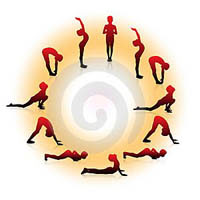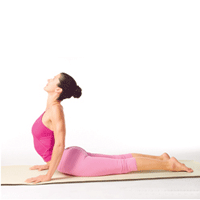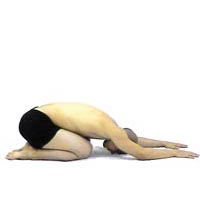Research indicates that yoga is one of the best alternative forms of treatment that helps to reduce the intensity of the asthma attacks and also contributes to a faster treatment of asthma. Regular practice of yoga asanas is highly beneficial as they enhance the airflow of the lungs, increase the air capacity and also improve the efficiency and stamina.
Here are some of the yogic ways through which you can keep your asthma at bay
Dandasana: This yogic asana is a good therapy for asthma. Just sit with an erect spine and keep your knees bent and then place your palms on either side of your hips and rest on the hips. Straighten your legs and then bring your legs closer to each other in the inward direction. Stretch your knees and toes and stretch the calf muscles. Extend your arms and elbows and then lift your abdomen for one minute. Hold this position for 30 seconds. Dandasana, when practiced regularly, brings down the level of asthma attacks.
Pranayama: It is one of the best breathing exercises which patients with asthma should practice. Place one finger on one of the nostril and  inhale through the other nostril and then exhale with the other nostril by slowly removing your finger. Repeat the procedure with the other nostril and see how it helps you calm down and treats asthma.
inhale through the other nostril and then exhale with the other nostril by slowly removing your finger. Repeat the procedure with the other nostril and see how it helps you calm down and treats asthma.
.
.
.
Dirga Pranayama: This is a normal process of cyclic breathing in which the lower abdomen, the upper chest, and ribcage are filled with air to fill the capacity of lungs. This process by enhancing the airflow of the lungs helps to counter asthma.
Ujjayi Pranayama: This breathing exercise helps to combat asthma caused due to cold air. It involves breathing through the nose by tightening the throat. It is just like sipping air with the help of a straw but is highly beneficial in treating asthma.
Kapalabhati Pranayama: This involves exhaling in a forceful manner with a significant amount of contraction of the muscles of the abdomen. The relaxation that follows should be used to inhale air. Repeat this process as it helps to strengthen the lungs and opens up the congestion.
If you are also affected by asthma, then practice these breathing exercises every day and see how it will bring down the levels of asthma in a gradual manner. However, for better results you will need to practice these exercises early in the morning.

 involves keeping hands and knees in a position of that of a
involves keeping hands and knees in a position of that of a  hips. Bend towards the hip joints and exhale.
hips. Bend towards the hip joints and exhale.  helps calm down the mind and brain and is also easy to practice. It also helps to increase the psychological and physical performance of kids. Make your child sit in a comfortable position with back straight, tell them to take several deep breaths and then breathe in and out through either of the nostrils until they get a sense of relaxation and calmness.
helps calm down the mind and brain and is also easy to practice. It also helps to increase the psychological and physical performance of kids. Make your child sit in a comfortable position with back straight, tell them to take several deep breaths and then breathe in and out through either of the nostrils until they get a sense of relaxation and calmness. The duration for practicing Padmasana depends on
The duration for practicing Padmasana depends on  up of twelve postures in all which need to be performed on a continuous basis and that too with synchronized breathing. There are numerous benefits of performing the Surya Namaskara. It activates all the
up of twelve postures in all which need to be performed on a continuous basis and that too with synchronized breathing. There are numerous benefits of performing the Surya Namaskara. It activates all the  This
This  means
means  stomach, kidneys, pancreas, liver, gallbladder and small intestines. When practiced regularly, this Asana can help to treat various problems such as constipation, diabetes, hay fever, sinusitis, menstrual disorders, bronchitis and urinary tract disorders.
stomach, kidneys, pancreas, liver, gallbladder and small intestines. When practiced regularly, this Asana can help to treat various problems such as constipation, diabetes, hay fever, sinusitis, menstrual disorders, bronchitis and urinary tract disorders. on a regular basis. It’s because; Surya Namaskara increases the blood supply to almost all the parts of the
on a regular basis. It’s because; Surya Namaskara increases the blood supply to almost all the parts of the  Regular practicing of Halasana,
Regular practicing of Halasana,  body. It provides a deep massage to
body. It provides a deep massage to  The duration for practicing Dhanurasana depends on
The duration for practicing Dhanurasana depends on  touches the ground. Once done, inhale and raise your forehead slowly. After this, you press your hands to raise your chest in the upward direction. Lift your chest in such a way so that it forms an arc in the backward direction far away from the floor. Practicing this asana for 3-5 times can keep stress away.
touches the ground. Once done, inhale and raise your forehead slowly. After this, you press your hands to raise your chest in the upward direction. Lift your chest in such a way so that it forms an arc in the backward direction far away from the floor. Practicing this asana for 3-5 times can keep stress away. towards the knee so that the nose touches your knee. Once done, loosen your shoulders and take long
towards the knee so that the nose touches your knee. Once done, loosen your shoulders and take long  palms facing upwards rest them away from your body. Once,
palms facing upwards rest them away from your body. Once,  side. Once done, raise your arms in the upward direction, straight above your head. After this, with your arms still in the upward direction, try to reach your shins and
side. Once done, raise your arms in the upward direction, straight above your head. After this, with your arms still in the upward direction, try to reach your shins and  This pose is helpful as it also helps to tranquilize the mind and lowers the blood pressure. To perform this asana, you just need to lie on the back in a way so that your head and back touches the floor. Once you lie down, hold your ankles and bring them up to your back or around your buttocks. While performing this asana breath in a usual way and then return to the original position.
This pose is helpful as it also helps to tranquilize the mind and lowers the blood pressure. To perform this asana, you just need to lie on the back in a way so that your head and back touches the floor. Once you lie down, hold your ankles and bring them up to your back or around your buttocks. While performing this asana breath in a usual way and then return to the original position. 2. Hero’s Pose (Virasana): This is one of the easiest yogic asanas which can help you get rid of menstrual disorders. In this asana, you just need to sit with a straight back and then slowly make your hips rest between the feet. While performing this asana see to it that your back is erect, and your toes are pointing backward. Breathe regularly and sit in this position for at least a period of 20 minutes to gain better results.
2. Hero’s Pose (Virasana): This is one of the easiest yogic asanas which can help you get rid of menstrual disorders. In this asana, you just need to sit with a straight back and then slowly make your hips rest between the feet. While performing this asana see to it that your back is erect, and your toes are pointing backward. Breathe regularly and sit in this position for at least a period of 20 minutes to gain better results. 3. Down Ffacing Hero’s Pose (Adho Mukha Virasana): Sit in the hero’s pose and bend in the forward direction and then rest on the floor. While resting, see to it that your forehead touches the ground. Once done, straighten both of your hands above your head and then join your palms together. Do this twice a day and for at least a period of 30-60 seconds for better results.
3. Down Ffacing Hero’s Pose (Adho Mukha Virasana): Sit in the hero’s pose and bend in the forward direction and then rest on the floor. While resting, see to it that your forehead touches the ground. Once done, straighten both of your hands above your head and then join your palms together. Do this twice a day and for at least a period of 30-60 seconds for better results.
 The Butterfly Pose: Also known as Titali Asana, this pose helps to open up the inner thighs and hips and relieves the pressure from the area of the inner thigh. Furthermore, the Titali asana also stretches your groin area. If you practice this asana from the first trimester period of your pregnancy, then you will not find any complications during childbirth.
The Butterfly Pose: Also known as Titali Asana, this pose helps to open up the inner thighs and hips and relieves the pressure from the area of the inner thigh. Furthermore, the Titali asana also stretches your groin area. If you practice this asana from the first trimester period of your pregnancy, then you will not find any complications during childbirth. erect and stretch your feet up to one inch apart and then inhale and simultaneously raise the arms in the upward direction and then raise the heels. Lower the arms and heels downwards as you exhale. This asana exercises the spine and abdominal muscles. However, if you practice this asana then stop raising the heels once you are three months pregnant.
erect and stretch your feet up to one inch apart and then inhale and simultaneously raise the arms in the upward direction and then raise the heels. Lower the arms and heels downwards as you exhale. This asana exercises the spine and abdominal muscles. However, if you practice this asana then stop raising the heels once you are three months pregnant.